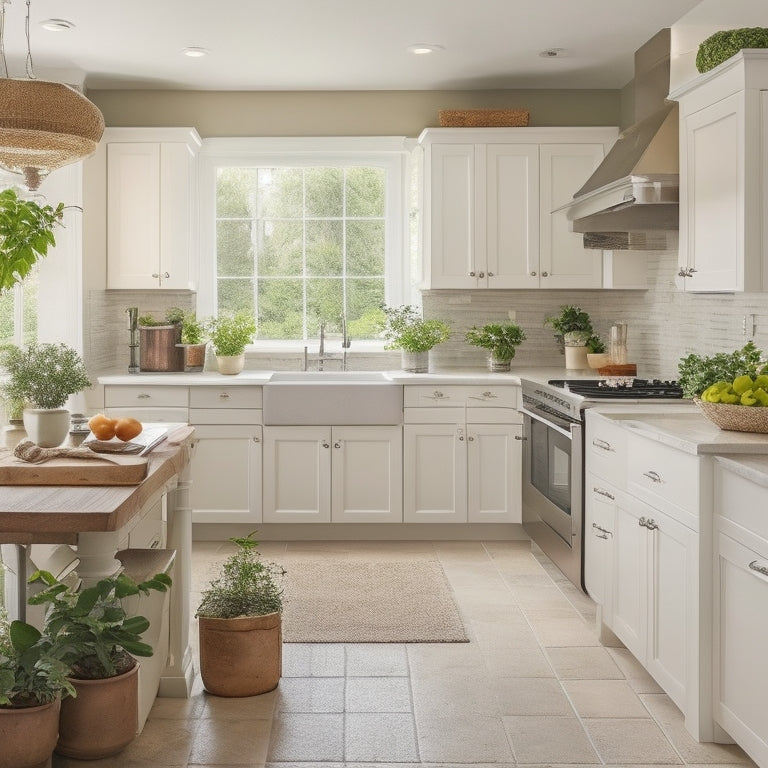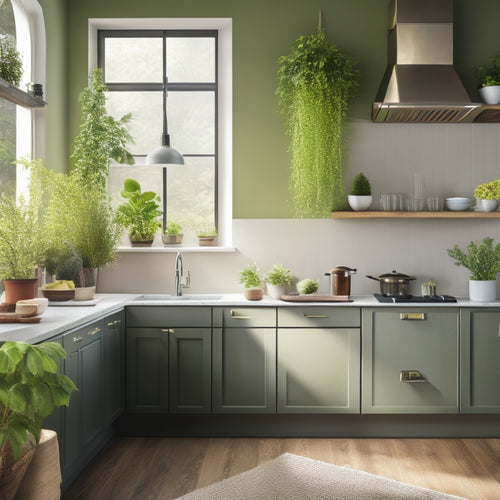
What Makes a Kitchen Clutter-Free and Functional?
Share
You want a kitchen that's clutter-free and functional, where you can cook with ease and find what you need when you need it. To achieve this, focus on a functional layout, efficient storage, and a well-organized pantry. Sort items into categories, assign a home for each, and implement practical hacks like drawer dividers and spice racks. By creating specific zones for tasks like food prep and cooking, you'll reduce clutter and streamline your workflow. With a little planning and creativity, you'll be whipping up meals in no time - and discover even more ways to optimize your kitchen's potential.
Key Takeaways
• A functional layout ensures a smooth workflow, reducing clutter and increasing efficiency in the kitchen.
• Efficient storage solutions, such as pantry organization systems and drawer dividers, keep items organized and easily accessible.
• Assigning a designated home for each item helps maintain a clutter-free kitchen and saves time searching for utensils and ingredients.
• Maximizing storage space through strategic cabinet organization, shelf extenders, and vertical storage solutions keeps countertops clear and organized.
• Implementing logical item placement and streamlining workflow processes enables cooks to work more efficiently and effectively in the kitchen.
Key Elements of Kitchen Organization
To achieve excellent kitchen organization, you must focus on three essential elements: a functional layout, efficient storage, and a maintenance routine that keeps clutter at bay.
A well-designed layout guarantees a smooth workflow, allowing you to move effortlessly between tasks. Efficient storage solutions, such as pantry organization systems, help keep items off countertops, reducing clutter and making the most of available space.
When it comes to storage, don't forget about the often-overlooked areas like drawers and countertops. Installing drawer dividers and a spice rack can help keep items tidy and within reach. This not only saves time but also reduces frustration when searching for a specific ingredient or utensil.
Decluttering Strategies That Work
By tackling clutter hotspots first, you'll gain momentum and make the entire decluttering process feel less overwhelming. Start by identifying areas that bother you the most, such as countertops, drawers, or shelves.
Once you've pinpointed these hotspots, adopt a decluttering mindset and sort items into three categories: keep, donate/sell, and discard. Be ruthless – if you haven't used it in the past year, it's likely you won't miss it.
Next, focus on implementing functional layout and organization hacks to maximize your kitchen's potential. Assess your storage solutions and consider investing in new ones, such as baskets, bins, or shelves, to keep items off the floor and out of sight.
Assign a home for each item, making sure it's easily accessible and logical. For instance, store frequently used utensils near the cooking station, and less frequently used items towards the back.
Maximizing Storage Space Effectively
As you work on maximizing storage space effectively in your kitchen, you'll want to focus on two key areas: optimizing your cabinet organization and utilizing vertical space.
By tackling these areas, you'll be able to fit more items into your kitchen without it feeling cluttered or cramped.
Optimize Cabinet Organization
You can greatly increase your kitchen's overall storage capacity by strategically organizing your cabinets to maximize every inch of available space. Start by evaluating your cabinet layout and identifying areas where you can optimize storage.
Consider installing drawer dividers to separate utensils, cookware, and dinnerware, keeping similar items together and making them easy to access. Shelf extenders can also be used to double the storage capacity of your shelves, allowing you to store more items without overcrowding.
Lazy susans are another great tool for maximizing cabinet space. These rotating shelves make it easy to access items in the back of your cabinets, reducing clutter and making cooking more efficient. Pull-out racks can also be installed to provide easy access to heavy cookware, pots, and pans.
Utilize Vertical Space
Make the most of your kitchen's vertical space by installing wall-mounted shelves, hooks, or racks to store infrequently used items, keeping them out of the way but still easily accessible. By doing so, you'll create a sense of openness and visual calm in your kitchen. This is especially important in smaller kitchens where every inch counts.
To utilize vertical space effectively, installing shelves or racks near the ceiling for items like infrequently used cookbooks, special occasion dishes, or kitchen gadgets is essential. You can also use wall-mounted pot racks, utensil holders, or spice racks to keep frequently used items within easy reach.
When choosing your storage solutions, don't forget to take into account your kitchen decor ideas. For instance, you can choose shelving units or racks that complement your kitchen's style and color scheme. By utilizing vertical space, you'll not only maximize your storage capacity but also create a more functional and aesthetically pleasing kitchen.
Essential Kitchen Zone Creation
Create essential kitchen zones by dividing your kitchen into distinct areas, each dedicated to a specific task or function, to maximize efficiency and productivity. This deliberate kitchen layout will help you stay focused and avoid clutter. By allocating specific zones for tasks like food preparation, cooking, and cleaning, you'll reduce the likelihood of clutter building up in one area.
To achieve zone efficiency, consider your daily routine and the tasks you perform most frequently. Designate a zone for meal prep, complete with a countertop, sink, and refrigerator access.
Another zone can be dedicated to cooking, with the stove, oven, and cookware storage nearby.
A cleaning zone can be created near the sink, with storage for cleaning supplies and a trash can.
Streamlining Kitchen Workflow Processes
Optimizing kitchen workflow processes involves identifying and eliminating inefficiencies that slow you down and drain your energy. By streamlining your workflow, you'll save time, reduce stress, and enjoy cooking more.
Start by analyzing your daily kitchen routine. Identify bottlenecks, such as overcrowded countertops or hard-to-reach utensils, and make adjustments to create a more efficient kitchen layout. Consider the 'work triangle' concept, where your sink, stove, and refrigerator form the points of a triangle to minimize walking distances.
Next, implement time-saving meal prep strategies, like chopping ingredients in advance or cooking proteins in bulk. This will free up time for more creative pursuits, like experimenting with new recipes or cooking techniques.
Additionally, designate specific zones for specific tasks, such as a prep area for chopping and a cooking zone for sautéing. By optimizing your workflow, you'll be able to cook faster, cleaner, and more efficiently, making meal prep a breeze.
With a well-organized kitchen, you'll be empowered to take control of your cooking and unleash your culinary creativity.
Choosing Multifunctional Products Wisely
By incorporating multifunctional products into your kitchen arsenal, you'll not only declutter your countertops but also streamline your cooking process. These space-saving solutions will help you maximize your kitchen's real estate, freeing up valuable space for more essential items.
When choosing multifunctional products, look for versatile tools that can perform multiple tasks with ease. For instance, a stand mixer that doubles as a food processor or a slow cooker with a built-in sauté function can be a game-changer. Consider the tasks you perform most frequently in your kitchen and seek out products that can tackle multiple tasks at once.
Implementing a Maintenance Routine
You'll want to set aside a few minutes each week to maintain your newly organized kitchen, making sure it remains clutter-free and functional for the long haul.
Daily maintenance is key to keeping your kitchen in top shape. Start by wiping down countertops and appliances after each meal, and tidying up clutter hotspots like the sink and stove areas.
Implement organization hacks like assigning a home for each item, using baskets and bins to store small items, and labeling everything to guarantee easy access.
Establish a cleaning routine that works for you, whether it's a weekly deep clean or daily quick pick-ups. Focus on high-traffic areas and prioritize tasks based on importance.
Don't forget to tackle clutter prevention by regularly going through your kitchen items and getting rid of anything unnecessary or broken.
Effective Use of Kitchen Technology
Two key areas where technology can greatly enhance your kitchen's functionality are meal planning and grocery shopping, and utilizing digital tools can streamline these tasks. You can use apps to plan your meals, generate shopping lists, and even order groceries online. This not only saves time but also reduces food waste and helps you stay organized.
Smart appliances, such as refrigerators with built-in touch screens, can also make a significant difference. These appliances can help you keep track of expiration dates, suggest recipes based on the ingredients you have, and even allow you to adjust settings remotely.
Space-saving gadgets like compact coffee makers and microwaves can also help optimize your kitchen's layout. By embracing kitchen tech innovations, you can create an efficient and organized cooking space that makes meal prep a breeze.
With the right organization solutions, you'll be able to focus on what matters most – cooking delicious meals and enjoying quality time with family and friends.
Overcoming Common Organizing Obstacles
As you start organizing your kitchen, you'll likely encounter some common obstacles that can hinder your progress.
You might find that your kitchen has limited storage space, making it challenging to keep everything tidy.
Additionally, you may discover clutter-hidden areas that have been accumulating messes for years, and addressing these challenges head-on is crucial to achieve your kitchen organization goals.
Limited Storage Space
In kitchens where every inch counts, limited storage space can quickly become a major obstacle to achieving an organized and functional cooking environment. You're not alone in this struggle, but it's time to think outside the box (or cabinet, in this case).
To overcome limited storage space, you need to uncover hidden treasures in your kitchen. Look for areas that can be repurposed or optimized for storage, such as the back of a door or the inside of a cabinet. Get creative with your solutions - consider installing a pegboard, using stackable containers, or investing in a kitchen cart with built-in storage.
Don't be afraid to think vertically, either; wall-mounted shelves or hooks can be a game-changer for small kitchens. By finding these hidden storage opportunities, you can free up space and create a more functional kitchen. Remember, it's all about maximizing every inch to create a cooking environment that works for you, not against you.
Clutter-Hidden Areas Found
Frequently, clutter accumulates in hidden areas, such as the top shelf of a pantry or the back of a cabinet, making it essential to ferret out these spaces and tame the chaos within.
You'll be surprised at how much clutter can accumulate in these hidden compartments, making it challenging to find what you need when you need it. To overcome this obstacle, start by clearing out these areas and implementing storage solutions that make sense for your kitchen.
Consider installing adjustable shelves, baskets, or bins to maximize storage capacity and keep items organized. This will help keep clutter at bay and make certain that your kitchen remains functional.
Additionally, think about the placement of your appliances and how they can impact the overall flow of your kitchen. By strategically placing your appliances, you can create clutter-free counters and a more efficient workspace.
Measuring Success in Kitchen Organization
You'll know you've achieved success in kitchen organization when every item has a designated home and you can effortlessly find what you need. This is the ultimate goal of measuring efficiency in kitchen organization.
When you've optimized your kitchen's layout and storage, you'll notice a significant reduction in time spent searching for utensils, ingredients, and cooking tools.
To evaluate your organization success, ask yourself: Can I find what I need in under 30 seconds? Do I've ample counter space for meal prep and cooking? Are my frequently used items easily accessible? Are my kitchen drawers and cabinets neatly organized and clutter-free? If you've answered 'yes' to these questions, you're well on your way to achieving a clutter-free and functional kitchen.
Frequently Asked Questions
How Do I Maintain My Kitchen Organization Over Time?
To maintain your kitchen organization over time, you'll need to master time management by scheduling daily tidying sessions and develop consistent habits, like putting things back in their assigned spots, to keep clutter at bay.
Can a Clutter-Free Kitchen Still Feel Cozy and Inviting?
As you step into your kitchen, imagine a warm hug enveloping you. Yes, a clutter-free kitchen can still feel cozy and inviting, blending cozy aesthetics with functional space, minimalist design, and a welcoming atmosphere that makes you feel empowered and in control.
Are Kitchen Organization Systems Worth the Investment?
You're wondering if kitchen organization systems are worth the investment. Honestly, they can be, but consider budget-friendly DIY solutions or a professional's touch. A minimalist approach and decluttering tips can also maximize your space without breaking the bank.
How Do I Involve My Family in Kitchen Organization Efforts?
You involve your family in kitchen organization by assigning tasks, setting boundaries, and promoting teamwork. Hold a family meeting to discuss responsibilities, and create a schedule to maintain accountability and make sure everyone's on board.
What Are Some Eco-Friendly Kitchen Organization Solutions?
You're looking for eco-friendly kitchen organization solutions that align with your values. Opt for eco-friendly storage made from sustainable materials like bamboo, recycled plastic, or reclaimed wood, which reduce waste and minimize environmental impact.
Related Posts
-

Baked Kale
Kale is one of the most healthiest and nutritious plant foods in existence and is delicious! Try these baked kale re...
-

3 Essential Steps to a Clutter-Free Kitchen
You'll reach a clutter-free kitchen by following three essential steps. First, purge and declutter by gathering items...
-
What's Holding You Back From Reaching Your Diet Goals?
You're struggling to reach your diet goals, and it's not because you're not trying hard enough. It's likely due to co...

